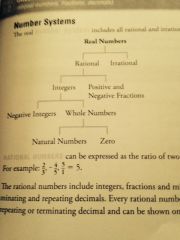![]()
![]()
![]()
Use LEFT and RIGHT arrow keys to navigate between flashcards;
Use UP and DOWN arrow keys to flip the card;
H to show hint;
A reads text to speech;
56 Cards in this Set
- Front
- Back
|
Prenumeration Concepts
|
-Place Value
-Base 10-standard -Place value chart -Number Sense: Understanding how #'s grouped into 10,100... -Naming Procedure: (0-12) Unique names (13-19) teens combination of names |
|
|
Number System
|

rational
integers whole numbers natural numbers irrational numbers percent decimal cardinals #'s Ordinal #'s |
|
|
Rational Numbers
|
can be expressed as ratio of two integers a/b not equal to 0
can be shown on the number line |
|
|
Integers
|
positive & negative whole #'s and zero (-2,-1,0,1,2)
|
|
|
Whole numbers
|
natural numbers and zero (0,1,2,3,4,5)
|
|
|
Natural Numbers
|
Counting #'s (1,2,3,4,5,6)
|
|
|
Irrational numbers
|
Real numbs that cannot be written as a ration of two numbers
cannot be shown on the number line |
|
|
Percent
|
Per 100
base 10 positional system for numbers |
|
|
Decimal
|
numbers written with a whole number decimal part and not decimal part
|
|
|
Cardinal numbers
|
counting numbers
|
|
|
ordinal numbers
|
indicate order of things in a set
do not show quality only position 1st, 2nd, 3ed, |
|
|
Commutative Property
|
order of factors and terms does not matter in addition and subtratction problems, answer will stay the same
4+2=6 2+4=6 4x2=8 2x4=8 |
|
|
Associative
|
Terms can be regrouped
(addition, multiplication) |
|
|
Identity Property
|
a term that when added (0) term results in that #
a term when multiplied by (1) equals that number |
|
|
Inverse Property
|
added results in 1 or
multiplied results in 0 |
|
|
GCF
|
the GREATEST COMMON FACTOR that two or more terms can be divided by
|
|
|
LCM
|
the least common multiple of two or more factors
|
|
|
Deductive Thinking
|
making a conclusion based on other statements that are true
|
|
|
inductive thinking
|
finding a pattern from a group of examples
|
|
|
Valid Argument
|
Deductive argument in which the conclusion necessarily follows from the premises
|
|
|
Conditional Statement
|
If p then q.... (p.. hypothesis q=conclusion)
|
|
|
Inverse Statment
|
if ~p then ~q (negate both hypothesis and conclusion
if not p and than not q |
|
|
Converse Statement
|
if q than p
revers 2 clauses: original hypothesis becomes conclusion and vise-vera |
|
|
Contrapostiive statment
|
if ~p than ~q above then negate both hypothesis and new conclusion
|
|
|
Proportions
|
solve word problems with compared relationships
|
|
|
Linear Relationship
|
two quantities are proportional (double x also doubles Y)
|
|
|
Non-Linear Relationship
|
relationship which change separately
one quantity does not effect other quantity to same extent |
|
|
Commutative Property example
|
a+b= b+a
|
|
|
Associative Property Example
|
(a+b)+c= a=(b+c)
|
|
|
Distributive Property Example
|
a(b+c) = ab=ac
|
|
|
Additive Identity
|
a+0=a
|
|
|
Multiplicative Identity
|
a X 1=a
|
|
|
Additive Inverse
|
a+a=0
|
|
|
Multiplictive Inverse
|
a X 1/5=1
|
|
|
Polyhedron
|
a simple closed surface and all point in its interior
|
|
|
Transformation
|
change in position shape or size
|
|
|
symmetry
|
exact size and shape: mirror images
|
|
|
translation
|
slides object a fixed distance in a given direction.
|
|
|
Dilation
|
transformation that shrinks object or makes it bigger
|
|
|
tessellation
|
like tiling: closed shapes that completely covers a plane
|
|
|
Euler's Formula
|
V+F = E+Z
|
|
|
Net
|
2D figure that can be cut and folded to make a 3D object.
|
|
|
Is the square of a number always greater than the number?
|
no. example 0 or fractions
numbers between -1 and 1 |
|
|
factor tree
(60) |
6*10
3*2 5*2 |
|
|
Percent increase equations
|
how much did it increase?
what was the original ex: if movie tickets were 5 dollars last week and 6 dollars this week what was the % increase 1/5=.2 or .2*5=1 and 5+1=6 |
|
|
Is (algebraic equation)
|
equals
|
|
|
Do rectangles with same perimeter always have same area?
|
no
ex: l=2 w=2 perimeter= 8 area = 4 l=1 w=3 perimeter= 8 area= 3 |
|
|
for a given shape what is the shape with the greatest area?
|
Square
|
|
|
if a figure is a rectangle is it also a square?
|
not always
|
|
|
if a figure is a square is it also a rectangle?
|
Yes
rectangle: is a quadrilateral with all four angles right angles. square: is a quadrilateral with all four angles right angles and all four sides of the same length. |
|
|
volume of cylinder equation
|
V=πr2h
|
|
|
sum of 3 angles in a triangle
|
180
|
|
|
sum of all angles of a square
|
360
|
|
|
isosceles triangel
|
two equal sides and angles
-Can be a right triangle |
|
|
hypotenuse
|
longest side of a right triangle
side opposite the right angle |
|
|
kilograms to pounds conversion
|
1 kilo ~2.2 lbs ("more than double)
|

